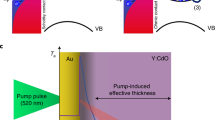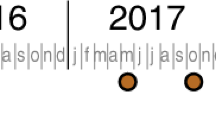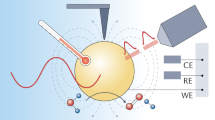Abstract
Strong interactions of electromagnetic fields with plasmonic nanomaterials have been exploited in various applications. These applications have centred on plasmon-enhanced scattering rates in nearby molecules or plasmon-induced heating. A question that has emerged recently is whether it is possible to use plasmonic nanostructures in a range of hot electron (hole) applications, including photocatalysis, photovoltaics and photodetection. These applications require coupling of a plasmonic component, which amplifies the interaction of light with the material, to an attached non-plasmonic component that extracts this energy in the form of electronic excitations to perform a function. In this Perspective, we discuss recent work in the emerging field of hybrid plasmonics. We focus on fundamental questions related to the nanoscopic flow of energy and excited charge carriers in these multicomponent materials. We also address critical misconceptions, challenges and opportunities that require more attention.
This is a preview of subscription content, access via your institution
Access options
Access Nature and 54 other Nature Portfolio journals
Get Nature+, our best-value online-access subscription
$29.99 / 30 days
cancel any time
Subscribe to this journal
Receive 12 print issues and online access
$259.00 per year
only $21.58 per issue
Buy this article
- Purchase on Springer Link
- Instant access to full article PDF
Prices may be subject to local taxes which are calculated during checkout





Similar content being viewed by others
References
Giannini, V., Fernández-Domínguez, A. I., Heck, S. C. & Maier, S. A. Plasmonic nanoantennas: fundamentals and their use in controlling the radiative properties of nanoemitters. Chem. Rev. 111, 3888–3912 (2011).
Schuller, J. A. et al. Plasmonics for extreme light concentration and manipulation. Nat. Mater. 9, 193–204 (2010).
Linic, S., Christopher, P. & Ingram, D. B. Plasmonic-metal nanostructures for efficient conversion of solar to chemical energy. Nat. Mater. 10, 911–921 (2011).
Linic, S., Aslam, U., Boerigter, C. & Morabito, M. Photochemical transformations on plasmonic metal nanoparticles. Nat. Mater. 14, 567–576 (2015).
Stiles, P. L., Dieringer, J. A., Shah, N. C. & Van Duyne, R. P. Surface-enhanced Raman spectroscopy. Annu. Rev. Anal. Chem. 1, 601–626 (2008).
Brus, L. Noble metal nanocrystals: plasmon electron transfer photochemistry and single-molecule Raman spectroscopy. Acc. Chem. Res. 41, 1742–1749 (2008).
Rao, V. G., Aslam, U. & Linic, S. Chemical requirement for extracting energetic charge carriers from plasmonic metal nanoparticles to perform electron-transfer reactions. J. Am. Chem. Soc. 141, 643–647 (2019).
Butet, J., Brevet, P.-F. & Martin, O. J. F. Optical second harmonic generation in plasmonic nanostructures: from fundamental principles to advanced applications. ACS Nano 9, 10545–10562 (2015).
Celebrano, M. et al. Mode matching in multiresonant plasmonic nanoantennas for enhanced second harmonic generation. Nat. Nanotechnol. 10, 412–417 (2015).
Stuart, D. A., Haes, A. J., Yonzon, C. R., Hicks, E. M. & Duyne, R. P. V. Biological applications of localised surface plasmonic phenomenae. IEE Proc. Nanobiotechnol. 152, 13–32 (2005).
Kabashin, A. V. et al. Plasmonic nanorod metamaterials for biosensing. Nat. Mater. 8, 867–871 (2009).
Aslam, U., Chavez, S. & Linic, S. Controlling energy flow in multimetallic nanostructures for plasmonic catalysis. Nat. Nanotechnol. 12, 1000–1005 (2017).
Ndukaife, J. C., Shalaev, V. M. & Boltasseva, A. Plasmonics—turning loss into gain. Science 351, 334–335 (2016).
Brongersma, M. L., Halas, N. J. & Nordlander, P. Plasmon-induced hot carrier science and technology. Nat. Nanotechnol. 10, 25–34 (2015).
Moskovits, M. The case for plasmon-derived hot carrier devices. Nat. Nanotechnol. 10, 6–8 (2015).
Clavero, C. Plasmon-induced hot-electron generation at nanoparticle/metal-oxide interfaces for photovoltaic and photocatalytic devices. Nat. Photon. 8, 95–103 (2014).
Nozieres, P. Theory of Quantum Liquids (CRC Press, 2018).
Kubo, A. et al. Femtosecond imaging of surface plasmon dynamics in a nanostructured silver film. Nano Lett. 5, 1123–1127 (2005).
Yannouleas, C. & Broglia, R. A. Landau damping and wall dissipation in large metal clusters. Ann. Phys. 217, 105–141 (1992).
Bohren, C. F. How can a particle absorb more than the light incident on it? Am. J. Phys. 51, 323–327 (1983).
Jain, P. K., Lee, K. S., El-Sayed, I. H. & El-Sayed, M. A. Calculated absorption and scattering properties of gold nanoparticles of different size, shape, and composition: applications in biological imaging and biomedicine. J. Phys. Chem. B 110, 7238–7248 (2006).
Khurgin, J. B. How to deal with the loss in plasmonics and metamaterials. Nat. Nanotechnol. 10, 2–6 (2015).
Hartland, G. V. Optical studies of dynamics in noble metal nanostructures. Chem. Rev. 111, 3858–3887 (2011).
Abelès, F. Optical Properties of Solids (Elsevier, 1972).
Boerigter, C., Campana, R., Morabito, M. & Linic, S. Evidence and implications of direct charge excitation as the dominant mechanism in plasmon-mediated photocatalysis. Nat. Commun. 7, 10545 (2016).
Kambhampati, P., Child, C. M., Foster, M. C. & Campion, A. On the chemical mechanism of surface enhanced Raman scattering: experiment and theory. J. Chem. Phys. 108, 5013–5026 (1998).
Khurgin, J. B. & Levy, U. Generating hot carriers in plasmonic nanoparticles: when quantization does matter? ACS Photon. 7, 547–553 (2020).
Trolle, M. L. & Pedersen, T. G. Indirect optical absorption in silicon via thin-film surface plasmon. J. Appl. Phys. 112, 043103 (2012).
Khurgin, J. B. & Sun, G. Scaling of losses with size and wavelength in nanoplasmonics and metamaterials. Appl. Phys. Lett. 99, 211106 (2011).
Boerigter, C., Aslam, U. & Linic, S. Mechanism of charge transfer from plasmonic nanostructures to chemically attached materials. ACS Nano 10, 6108–6115 (2016).
Brown, A. M., Sundararaman, R., Narang, P., Goddard, W. A. & Atwater, H. A. Nonradiative plasmon decay and hot carrier dynamics: effects of phonons, surfaces, and geometry. ACS Nano 10, 957–966 (2016).
Foerster, B., Spata, V. A., Carter, E. A., Sönnichsen, C. & Link, S. Plasmon damping depends on the chemical nature of the nanoparticle interface. Sci. Adv. 5, eaav0704 (2019).
Sundararaman, R., Narang, P., Jermyn, A. S., Goddard, W. A. III & Atwater, H. A. Theoretical predictions for hot-carrier generation from surface plasmon decay. Nat. Commun. 5, 5788 (2014).
Narang, P., Sundararaman, R. & Atwater, H. A. Plasmonic hot carrier dynamics in solid-state and chemical systems for energy conversion. Nanophotonics 5, 96–111 (2016).
Chavez, S., Aslam, U. & Linic, S. Design principles for directing energy and energetic charge flow in multicomponent plasmonic nanostructures. ACS Energy Lett. 3, 1590–1596 (2018).
Christopher, P. & Moskovits, M. Hot charge carrier transmission from plasmonic nanostructures. Annu. Rev. Phys. Chem. 68, 379–398 (2017).
Chavez, S., Govind Rao, V. & Linic, S. Unearthing the factors governing site specific rates of electronic excitations in multicomponent plasmonic systems and catalysts. Faraday Discuss. 214, 441–453 (2019).
Tan, S. et al. Plasmonic coupling at a metal/semiconductor interface. Nat. Photon. 11, 806–812 (2017).
Foerster, B. et al. Interfacial states cause equal decay of plasmons and hot electrons at gold–metal oxide interfaces. Nano Lett. 20, 3338–3343 (2020).
Engelbrekt, C., Crampton, K. T., Fishman, D. A., Law, M. & Apkarian, V. A. Efficient plasmon-mediated energy funneling to the surface of Au@Pt core–shell nanocrystals. ACS Nano 14, 5061–5074 (2020).
Wu, K., Chen, J., McBride, J. R. & Lian, T. Efficient hot-electron transfer by a plasmon-induced interfacial charge-transfer transition. Science 349, 632–635 (2015).
Foerster, B. et al. Chemical interface damping depends on electrons reaching the surface. ACS Nano 11, 2886–2893 (2017).
Hendrich, C. et al. Chemical interface damping of surface plasmon excitation in metal nanoparticles: a study by persistent spectral hole burning. Appl. Phys. B 76, 869–875 (2003).
Stietz, F. et al. Decay times of surface plasmon excitation in metal nanoparticles by persistent spectral hole burning. Phys. Rev. Lett. 84, 5644–5647 (2000).
Ziegler, T., Hendrich, C., Hubenthal, F., Vartanyan, T. & Träger, F. Dephasing times of surface plasmon excitation in Au nanoparticles determined by persistent spectral hole burning. Chem. Phys. Lett. 386, 319–324 (2004).
Therrien, A. J. et al. Impact of chemical interface damping on surface plasmon dephasing. Faraday Discuss. 214, 59–72 (2019).
Moskovits, M. & DiLella, D. P. in Surface Enhanced Raman Scattering (eds Chang, R. K. & Furtak, T. E.) 243–273 (Springer, 1982).
Xu, H., Aizpurua, J., Käll, M. & Apell, P. Electromagnetic contributions to single-molecule sensitivity in surface-enhanced Raman scattering. Phys. Rev. E 62, 4318–4324 (2000).
Nie, S. & Emory, S. R. Probing single molecules and single nanoparticles by surface-enhanced Raman scattering. Science 275, 1102–1106 (1997).
Sivan, Y., Un, I. W. & Dubi, Y. Assistance of metal nanoparticles in photocatalysis – nothing more than a classical heat source. Faraday Discuss. 214, 215–233 (2019).
Dubi, Y. & Sivan, Y. “Hot” electrons in metallic nanostructures—non-thermal carriers or heating? Light Sci. Appl. 8, 89 (2019).
Tagliabue, G. et al. Quantifying the role of surface plasmon excitation and hot carrier transport in plasmonic devices. Nat. Commun. 9, 3394 (2018).
Cortes et al. Plasmonic hot electron transport drives nano-localized chemistry. Nat. Commun. 8, 14880 (2017).
Christopher, P., Xin, H. & Linic, S. Visible-light-enhanced catalytic oxidation reactions on plasmonic silver nanostructures. Nat. Chem. 3, 467–472 (2011).
Mukherjee, S. et al. Hot electrons do the impossible: plasmon-induced dissociation of H2 on Au. Nano Lett. 13, 240–247 (2013).
Christopher, P., Xin, H., Marimuthu, A. & Linic, S. Singular characteristics and unique chemical bond activation mechanisms of photocatalytic reactions on plasmonic nanostructures. Nat. Mater. 11, 1044–1050 (2012).
Seemala, B. et al. Plasmon-mediated catalytic O2 dissociation on Ag nanostructures: hot electrons or near fields? ACS Energy Lett. 4, 1803–1809 (2019).
Zhou, L. et al. Quantifying hot carrier and thermal contributions in plasmonic photocatalysis. Science 362, 69–72 (2018).
Kim, Y., Smith, J. G. & Jain, P. K. Harvesting multiple electron–hole pairs generated through plasmonic excitation of Au nanoparticles. Nat. Chem. 10, 763–769 (2018).
Marimuthu, A., Zhang, J. & Linic, S. Tuning selectivity in propylene epoxidation by plasmon mediated photo-switching of Cu oxidation state. Science 339, 1590–1593 (2013).
Kale, M. J., Avanesian, T. & Christopher, P. Direct photocatalysis by plasmonic nanostructures. ACS Catal. 4, 116–128 (2014).
Hartland, G. V., Besteiro, L. V., Johns, P. & Govorov, A. O. What’s so hot about electrons in metal nanoparticles? ACS Energy Lett. 2, 1641–1653 (2017).
Jermyn, A. S. et al. Transport of hot carriers in plasmonic nanostructures. Phys. Rev. Mater. 3, 075201 (2019).
Bonn, M. et al. Phonon- versus electron-mediated desorption and oxidation of CO on Ru(0001). Science 285, 1042–1045 (1999).
Hatch, S. R., Zhu, X. Y., White, J. M. & Campion, A. Photoinduced pathways to dissociation and desorption of dioxygen on silver (110) and platinum (111). J. Phys. Chem. 95, 1759–1768 (1991).
Zhou, X.-L., Zhu, X.-Y. & White, J. M. Photochemistry at adsorbate/metal interfaces. Surface Sci. Rep. 13, 73–220 (1991).
Denzler, D. N., Frischkorn, C., Hess, C., Wolf, M. & Ertl, G. Electronic excitation and dynamic promotion of a surface reaction. Phys. Rev. Lett. 91, 226102 (2003).
Aslam, U., Rao, V. G., Chavez, S. & Linic, S. Catalytic conversion of solar to chemical energy on plasmonic metal nanostructures. Nat. Catal. 1, 656–665 (2018).
Kazuma, E., Jung, J., Ueba, H., Trenary, M. & Kim, Y. Real-space and real-time observation of a plasmon-induced chemical reaction of a single molecule. Science 360, 521–526 (2018).
Anisimov, S. I. & Rethfeld, B. Theory of ultrashort laser pulse interaction with a metal. In Nonresonant Laser-Matter Interaction (NLMI-9) Vol. 3093 (ed. Libenson, M. N.) 192–203 (International Society for Optics and Photonics, 1997).
Brown, A. M. et al. Experimental and ab initio ultrafast carrier dynamics in plasmonic nanoparticles. Phys. Rev. Lett. 118, 087401 (2017).
Frischkorn, C. & Wolf, M. Femtochemistry at metal surfaces: nonadiabatic reaction dynamics. Chem. Rev. 106, 4207–4233 (2006).
An, X., Stelter, D., Keyes, T. & Reinhard, B. M. Plasmonic photocatalysis of urea oxidation and visible-light fuel cells. Chem 5, 2228–2242 (2019).
Swearer, D. F. et al. Heterometallic antenna−reactor complexes for photocatalysis. Proc. Natl Acad. Sci. USA 113, 8916–8920 (2016).
Sytwu, K., Vadai, M. & Dionne, J. A. Bimetallic nanostructures: combining plasmonic and catalytic metals for photocatalysis. Adv. Phys. X 4, 1619480 (2019).
Li, W. & Valentine, J. G. Harvesting the loss: surface plasmon-based hot electron photodetection. Nanophotonics 6, 177–191 (2017).
Mali, S. S., Shim, C. S., Kim, H., Patil, P. S. & Hong, C. K. In situ processed gold nanoparticle-embedded TiO2 nanofibers enabling plasmonic perovskite solar cells to exceed 14% conversion efficiency. Nanoscale 8, 2664–2677 (2016).
Li, Y. et al. Superior plasmonic photodetectors based on Au@MoS2 core–shell heterostructures. ACS Nano 11, 10321–10329 (2017).
Atwater, H. A. & Polman, A. Plasmonics for improved photovoltaic devices. Nat. Mater. 9, 205–213 (2010).
Lopez-Sanchez, O., Lembke, D., Kayci, M., Radenovic, A. & Kis, A. Ultrasensitive photodetectors based on monolayer MoS2. Nat. Nanotechnol. 8, 497–501 (2013).
Acknowledgements
The work presented in this document was supported by the National Science Foundation (NSF) (CHE-1800197). Secondary support was provided by the US Department of Energy, Office of Science, Office of Basic Energy Sciences (DE-SC0021362) (analysis of optical interactions of materials with light) and the Office of Basic Energy Science, Division of Chemical Sciences (DE-SC0021008) (materials synthesis).
Author information
Authors and Affiliations
Contributions
S.L. wrote the manuscript. All authors were involved in discussions, gathering of literature and figure design.
Corresponding author
Ethics declarations
Competing interests
The authors declare no competing interests.
Additional information
Peer review information Nature Materials thanks Emiliano Cortés, Prineha Narang and Sebastian Schlücker for their contribution to the peer review of this work.
Publisher’s note Springer Nature remains neutral with regard to jurisdictional claims in published maps and institutional affiliations.
Rights and permissions
About this article
Cite this article
Linic, S., Chavez, S. & Elias, R. Flow and extraction of energy and charge carriers in hybrid plasmonic nanostructures. Nat. Mater. 20, 916–924 (2021). https://doi.org/10.1038/s41563-020-00858-4
Received:
Accepted:
Published:
Issue Date:
DOI: https://doi.org/10.1038/s41563-020-00858-4
This article is cited by
-
Light-driven nanoscale vectorial currents
Nature (2024)
-
Pt-doped Ru nanoparticles loaded on ‘black gold’ plasmonic nanoreactors as air stable reduction catalysts
Nature Communications (2024)
-
Plasmonic chemistry for sustainable ammonia production
Communications Materials (2024)
-
Theoretical Investigation of Surface Plasmon Polariton Propagation in Grating Nanostructure with Perturbation Approach
Plasmonics (2024)
-
Plasmonic bimetallic two-dimensional supercrystals for H2 generation
Nature Catalysis (2023)



